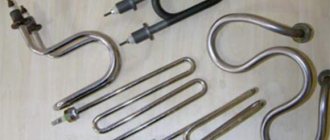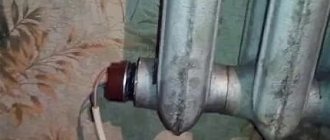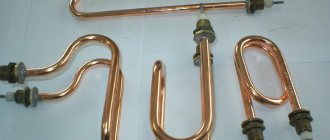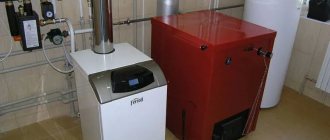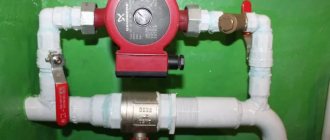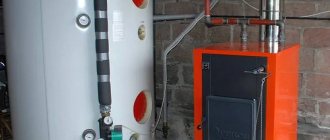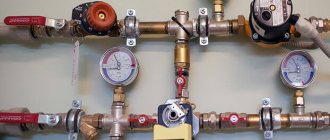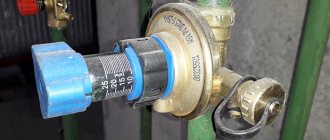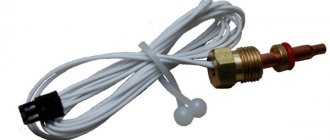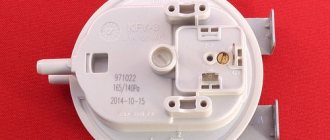When operating a heating boiler, it is necessary to control the pressure: too much can create an emergency situation, and too low will lead to a decrease in the efficiency of the heating. There are various methods of control. They include various types of automation, regulation of water flow into the boiler, control of the heating process of the coolant. The home owner must understand how the heating system works, how to properly regulate the pressure in it, and how the pressure sensor in the heating system works.
Sensors that monitor the operation of the boiler Source stroy-podskazka.ru
Why is it important to control your blood pressure?
For proper operation of the heating system, it is important that the pressure is within certain limits. Otherwise, the process of movement of the coolant through the pipes will be disrupted and the necessary heating of the room will not be provided.
In a heating boiler, the pressure level is related to how heating is carried out. Therefore, a temperature sensor is often used simultaneously with its sensor. If the pressure increases excessively, this can lead to an emergency. When it drops, the heat transfer process will be disrupted due to the slowdown in the movement of the coolant.
The use of an autonomous heating system helps citizens not to depend on a centralized system. This is useful where a private house does not have such an opportunity. Some owners choose this solution in order to save money.
If there are malfunctions, you need to contact a specialist Source priority-perm.rf
In both cases, it is important to achieve savings in fuel consumption. The pressure sensor saves money because it can be used to adjust the heating depending on the temperature and pressure in the boiler. It helps to turn on the pumps only when really needed. This saves energy for their operation and reduces equipment wear.
The sensors in question affect the quality of operation of the entire heating system. It is believed that the functionality of the heating boiler, pipes and radiators determines the efficiency of heating by 80%.
When the boiler functions as a hydraulic accumulator in a private house, water is pumped into it using pumps, which is necessary for consumption inside the house: for working in the kitchen, washing and other functions. If the pumps to ensure the supply of water operate continuously, the pressure in the boiler will increase, which can lead to damage to it or damage to elements of the home water supply network. If the pumping becomes weak, then the water from the tap will have little pressure.
Pressure sensors are connected to relays, which at the right times turn on or off the flow of water depending on the achieved pressure level. The timeliness of these actions ensures that the pressure in the boiler is maintained within the required limits. At the same time, the organization of the optimal mode of use of pumps is ensured.
Pressure sensor device Source crast.ru
Installing a DHW temperature controller
An automatic temperature controller will ensure rational heat consumption and stable hot water temperature.
The OTOS company is ready to carry out a full range of work on installing a water temperature regulator in a heating point of a hot water supply system.
- We will develop and approve the project
- We will supply equipment and materials
- Install a water temperature regulator
- Let's start the DHW system and set up the regulator
- We will conclude a maintenance contract
The regulator installation project is carried out by certified specialists with many years of experience. All projects are developed individually, and the selection is accompanied by detailed calculations.
The installation of a temperature regulator in a hot water supply system will be carried out by an experienced team using modern tools and materials. Installed equipment, materials and work performed are provided with a two-year guarantee.
How does a regulator maintain water temperature?
The regulator valve is installed on the supply pipeline of the heating network in front of the heat exchanger (boiler), and the temperature sensor is installed at the outlet of the heated water from the heat exchanger.
The sensor measures the temperature of the heated water at the entrance to the hot water supply system and transmits a control signal to the control valve drive to increase or decrease the flow of heating fluid. When the set temperature is exceeded, the regulator shuts off the heating flow, and when it is too low, it opens it.
Types of water temperature controllers
Direct acting temperature controller
The temperature sensor of such a regulator is a canister filled with gas and connected by a pulse tube to a bellows drive. The gas heats up in the temperature sensor (canister) and expands, and accordingly, the pressure in it and in the drive increases - the bellows of the drive expands and presses on the regulator rod, blocking the flow. When cooled, the opposite effect occurs.
Direct-acting temperature controllers operate without external power sources, but have a limited temperature range and cannot be programmed to maintain different temperatures depending on the day of the week or time of day.
Programmable temperature controller
Consists of a sensor, controller, electric actuator and control valve. The sensor transmits temperature data to the controller, which checks the measured temperature with the specified setting and, if it deviates, generates a control signal for the electric drive that closes or opens the control valve.
Programmable regulators are powered from an external network, maintain water temperature with greater accuracy and can provide different temperatures depending on the day of the week and time of day.
How much can you reduce your hot water costs?
Excess heat consumption in a hot water supply system whose water heating installation is not equipped with a temperature controller can reach 30%
. At the same time, during the absence of water withdrawal and, accordingly, heat removal, the hot coolant from the supply pipeline of the heating network flows into the return pipeline, which is not allowed under the conditions of heat supply in centralized heating networks and entails the imposition of a fine and an increase in heat losses from the pipelines.
Installing a DHW temperature controller
Control methods
The state of the heating system can be partially controlled using temperature sensors. They are used to perform various functions. In particular, the pressure in a gas boiler depends on temperature. Using such sensors, you can evaluate the heating efficiency.
However, its use is not enough to regulate the operation of the heating boiler. In this case, the pressure sensor plays the main role. Failure to control the increase in pressure can lead to an accident. Therefore, the installation of such a sensor is necessary. If it is not included in the boiler design, then if there is forced circulation, the owner must install it additionally.
Industrial boiler for heating water Source temron.ru
Conclusions and useful video on the topic
The video below describes in detail how to install thermal devices on a heating boiler:
Is the installation of sensors on the supply and return pipes different?
Temperature sensors are widely used both in various industries and for domestic purposes. A large assortment of similar devices, which are based on different operating principles, allows you to choose the best option for solving a particular problem.
In houses and apartments, such devices are most often used to maintain a comfortable temperature in the premises, as well as to regulate heating systems - radiators, heated floors.
Do you have anything to add, or do you have questions about choosing and installing a temperature sensor?
You can leave comments on the publication, participate in discussions and share your own experience of using such devices. The contact form is located in the lower block. Date: September 25, 2022
What are pressure sensors used for?
Pressure is influenced by two factors: the flow of water into the boiler and its heating. The maximum permissible pressure should not exceed that which the boiler can withstand. It is desirable that it be less than the limit value by 0.5 atm or more.
The lower value is selected based on ensuring the required degree of heating in the house. In this case, it is necessary that the heating is not turned on too often. Usually in private houses the minimum value is 1.5 MPa and the maximum is 2.5 MPa. However, each time it is necessary to select individually. In this case, the optimal value can be in the range of up to 6 MPa.
Boiler pressure sensor Source teplo-plus.net
Sensors can have different types of designs. The simplest ones are mechanical or electrical. Some are designed to control a relay that closes or opens pipes.
Some varieties are equipped with pressure gauges so that a person can control the pressure level. A mechanism may be provided to prevent sudden changes in water.
It is important that the relay operation frequency is not too high. It depends on the volume of the hydraulic accumulator used in the pressure system and the number of devices consuming water at the moment.
Connecting a pressure sensor Source eteh.com.ua
For example, if in a private house they take a bath, do laundry and wash dishes at the same time, the relay will turn on the pump more often. This is due to higher water consumption than usual. Because of this, the pressure will begin to drop and the relay will operate. As a result, water pumping will begin. Due to the waste of water, the pressure will again drop to the lower limit and the relay will have to turn on the pump again. When the flow rate decreases to the normal value, the operating frequency will return to the normal value.
If the device is equipped with a pressure gauge, the owner can control the pressure level in the system. If it differs from the standard, it will be possible to understand the reasons for what is happening and take appropriate measures.
Heating boiler design Source teplo-teh.com
How to install regulators correctly
For proper installation, no special knowledge of heating engineering is required; it is enough to follow the following rules:
- The device crashes into the battery at the feed, and not at the exit
; - The nominal diameter of the passage of the device must correspond to the diameter of the supply pipes;
- If several radiators in a room are connected in series, then it makes no sense to install the device on each one separately - you can regulate the flow at the input of the first one. If a single-pipe heating system is used or each battery is connected to a separate riser (with vertical wiring), then a separate regulator is required for each battery;
- When installing the device, its head, in which the bellows is located, must be in a horizontal position so that stagnant zones do not form around it. It should also be blown with air from the room, and not with rising air currents from the pipes. In addition, it is more convenient to set the adjusting drum in the desired position.
For the same purpose, it is desirable that the head is not covered with curtains or decorative screens;
For correct operation of the regulator, its head should not be exposed to direct sunlight.
You might be interested to know
The effectiveness of using thermostats for radiators will vary in each individual case. However, we can say for sure that if you have at least sometimes experienced discomfort associated with high indoor temperatures, then the economic effect will be guaranteed. The second most important advantage of the installation is the ability to equalize the temperature in different rooms. For example, if in your house the room that is closest to the boiler warms up excessively, and in the distant rooms you have to look for a blanket or sweatshirt, then such a misunderstanding can be solved by installing thermostats on nearby radiators. To answer your question literally, yes, it really works.
In my opinion, installing a regulator on batteries to save on utility bills is not profitable. Firstly, to really save money, you need to install meters in your apartment, they themselves will cost a pretty penny, plus the work, plus the running around with paperwork. In an apartment building, if the house is old and there are no heat meters in each apartment, this will be of little use. And temperature regulation is also a dubious issue, it depends on the house - some people are so hot that they can’t breathe, while others are freezing. In a private house, I would be happy to install regulators, but the question arises: is it necessary to replace the heating radiators with modern ones? I have old Soviet ones everywhere.
There are several types of battery-mounted thermostats, including designs with a remote thermostatic sensor. All of them are designed for installation on radiators of any type, including old cast iron and steel models. Even if your home’s heating system is installed from something very exotic, you can always use an adapter from one thread size to another (all threads are unified). There is no problem to establish, the question is whether this will disrupt the normal operation of the heating
It is important that the temperature control valve is fully open to provide the required volume of circulation on the coldest days. This requirement is especially important for single-pipe heating systems
It is advisable (I would even say mandatory) to install thermal heads with maximum throughput in them. The manufacturer positions such devices as valves for one-pipe systems, and the line of such devices allows connection to batteries with a threaded connection from 1/2″ to 1″. Proper installation involves installing a three-way valve with a bypass section, which is necessary in order to not stop the flow of coolant in the system. I note that if the installation of a thermostat in a two-pipe heating system can be performed by a person with minimal plumbing skills, then intervention in a single-pipe structure requires certain qualifications and a competent approach.
Before we installed a regulator on the radiator in the house, we regulated the heating ourselves, but it was very troublesome and it happened so often that when it was very hot, we turned off the heating at night and froze, and when it seemed cold and we turned it on more, we had to open the windows and ventilate, that is, heat the street. And with the regulator, we set a certain comfortable temperature and don’t worry anymore.
Features of control of heating boilers
When measuring pressure in heating boilers, two types of sensors are used:
- for steam;
- for water.
Such devices are usually called pressure switches. They have a more complex organization compared to conventional pressure sensors. The sensor readings determine the level of coolant pumping, the operation of fans to cool the boiler, and control the operation of the burners. Pressure switches can be designed to operate with a maximum pressure level, a minimum pressure level, or use a combined approach.
Sensors that monitor gas pressure are designed primarily to control the intensity of water heating. If the pressure is too high, the burners must work less intensely. If it is not enough, you need to heat the water better. When choosing relays for heating boilers, you need to ensure that they correspond to the features of specific models.
When the heating system is operating, the pressure in the system must be within certain limits. It should be such as to ensure normal coolant circulation. If the value goes beyond the limits, then as a result the movement of the coolant may stop.
Heating systems can provide for static or dynamic pressure changes. In the first case, the coolant moves naturally and without the use of pumping. In the second, a higher pressure must be provided at the inlet than at the outlet.
For the boiler to operate efficiently, it is necessary to correctly configure the pressure sensor Source oboiman.ru
Temperature sensors for heating
Even at the heating design stage, it is necessary to select thermal sensors for heating - types and their characteristics. First of all, they differ in their installation location - directly into the system or for remote monitoring of other temperature indicators. The latter are used in conjunction with room thermostats.
Immersion sensors
Immersion thermometer
Designed to take readings about the heating of water in pipes. Their installation is carried out in certain areas of the system. Some models of solid fuel boilers do not have temperature sensors for heating. Therefore, it is imperative to eliminate this.
The choice of model depends on the method of taking readings.
- Bimetallic . The design of these temperature sensors for the heating system consists of a dial indicator and two metal plates made of different metals. When heated, one of them begins to deform, creating pressure on the indicator needle. This technique is characterized by high accuracy of readings, but has one drawback - relatively high inertia. Average price - from 600 to 900 rubles;
- Alcohol . Compared to the view described above, there is practically no inertia in displaying the water heating value. The principle of operation is in many ways similar to a conventional thermometer - an alcohol-containing composition is placed in a sealed flask, which expands when heated. The marks on the bulb of heating temperature sensors of this type indicate the current value of water heating. The design is simple, but inconvenient for monitoring readings. Cost – from 1900 rubles.
To install these heat sensors for heating, you first need to read the instructions from the manufacturer. It specifies the installation dimensions for connection to the pipe, temperature limits and recommendations for operation.
When choosing immersion thermometers, you need to consider the length of the sleeve. It can be from 120 to 160 mm.
Remote sensors
Remote temperature sensor
They are located outside the heating system, but can be connected to the boiler or programmer to adjust the parameters. Recently, wireless models that transmit information using auxiliary electronics have become popular. This makes it possible to install them almost anywhere - in a separate room or outdoors.
Defining characteristics of heating temperature control sensors:
- Signal range;
- Availability of autonomous power supply elements – batteries;
- Measurement error.
For simple circuits, you can install wired temperature sensors for the heating system. The signal is transmitted from the thermometer to the control device (or boiler) via wires. In this case, the likelihood of errors or incorrect data is much less than with wireless models.
For better communication of remote thermometers with other equipment, it is best to choose models from the same brand (manufacturer).
Principle of operation
Water pressure adjustment is carried out in accordance with the following algorithm:
- The taps open. After this, water from the boiler enters the heating system. At the same time, the coolant level decreases, and the pressure also decreases.
- The sensor monitors the pressure so that it does not become too weak. At the moment when the pressure reaches the threshold value, the relay contacts close.
- As a result, a pump is started that pumps water from a well or other external source.
- Due to the influx of water, the pressure will increase. The sensor will monitor when it reaches the maximum permissible value.
- At the moment when this happens, the relay is activated, causing the contacts to open. The pumps now stop working.
Boiler operation diagram Source teplo-klimat.com.ua
As a result, it is possible to maintain pressure within the specified limits. At the same time, it will not fall too much and will not rise so much that there is a risk of an emergency. The sensors not only regulate pressure, but also transmit its value to an external sensor so that the necessary information is available to the master. Periodically turning off the engine prevents it from running idle.
Operating principle of the temperature controller
The thermostat for heating radiators consists of a thermostatic head and a valve, the latter playing the role of a so-called actuator. The head, in turn, consists of a cylinder filled with a working substance that is sensitive to temperature fluctuations. Actually, thanks to this, the thermostat performs its function.
When the temperature rises, the volume of the working fluid increases, and if it decreases, then vice versa. During this, the pressure rod, which is connected to the cylinder, moves. The thermostatic head is installed on the valve. When expansion/compression occurs, the rod releases or compresses the locking cone located under the spring (this cone is necessary to close/open the hole through which the coolant is supplied).
The regulator can operate on a liquid or gaseous working substance; according to this parameter, in fact, all devices are divided into two large groups. Gas-filled thermostats are more sensitive to temperature changes, but liquid thermostats respond more accurately to pressure surges in the device, so the temperature can be adjusted with maximum accuracy.
Note! The principle of operation of the regulator is the same for all heating systems - both single- and double-pipe. The only difference is the resistance of the valves: in the first case it is significantly lower than in the second
Mechanism of action
The main element of a mechanical sensor is an elastic membrane. On the one hand, it is affected by the liquid in the boiler. It bends, acting on structural elements that allow you to accurately determine the amount of pressure. When the threshold value is reached, the relay performs its intended action - closing or opening the contacts. The minimum and maximum thresholds are set using two springs of different diameters. As soon as the membrane presses on them, the corresponding action is performed.
A mechanical pressure sensor in a heating system can also have the following operating scheme. It is mounted so that water enters the cylindrical hole.
It will put pressure on the elastic membrane, which will bend under the influence of pressure. Behind the membrane there is a conductive metal disk, which will be displaced by a greater amount, the stronger the liquid acts on the membrane.
Sensors must be easily accessible Source sovet-ingenera.com
There are protruding parts along the edges of the disk. When the disk advances, the contacts are closed. This will turn on the relay. If the pressure decreases, the curvature of the membrane will decrease and the disk will open the circuit. As a result, the relay will turn off.
In this way, the pumps will be turned on or off depending on the presence of a certain pressure in the boiler. The disk may have two pairs of protrusions of different sizes. Depending on the degree of exposure to water, the connection of different contacts will occur at different pressure values.
The electrical sensor uses a different operating principle. Here the main element is still the membrane, but its deformation is converted into an electrical analog signal. Next, it is strengthened to the desired level. Then it is converted into a discrete form. It is supplied to the control unit, which, depending on its value, supplies the corresponding control signal intended to close or open the contacts.
There are also electromechanical devices. They must include a pressure gauge. However, it uses three arrows. Two of them indicate the minimum and maximum pressure values, and one indicates its current value. When the parameter reaches a critical value, the circuit closes and, as a result, a command is given using a relay to turn the pumps on or off.
Heating system in a private house Source aqua-rmnt.com
Typically the membrane is located inside a tube of circular or elliptical cross-section. It shifts from the pressure in the boiler and affects the pressure gauge readings and the operation of the relay. When choosing mechanical sensors, the following requirements must be taken into account:
- It is important to consider measurement error. It should not be so large that it distorts the results.
- When choosing a household pressure gauge, the accuracy class should not be lower than 2.5.
- It must be remembered that the sensor is used in intensive mode. As a result of prolonged use, the instrument's readings may become less accurate.
It is recommended to calibrate the sensor before the start of each heating season.
The advantages of mechanical type sensors are affordable cost and higher reliability. Electric ones provide better functionality. For example, here you can organize a connection after an emergency shutdown has occurred. Some models provide transmission of signals to the owner's mobile phone.
Pressure sensor with a relief valve Source otivent.com
It should be borne in mind that there are other types of sensors under consideration, but they are relatively rare. An example is liquid devices. This scheme uses the principle of communicating vessels. In this case, the liquid inside the boiler is discharged outside into a vertical transparent tube.
Depending on the height to which it rises, one can judge the amount of pressure. This method is highly accurate, but it is usually used only in laboratory conditions.
Differential type devices are also used. Here, two cameras are used for measurement, the connection between which is made in the form of a sensitive element. Typically, such measuring instruments are used as remote ones.
Multifunctional electronic boiler pressure and temperature control system Source owen.ru
Connection nuances
Let's talk a little about how to connect such a device. Ceiling or wall heaters can work normally, but the efficiency of the built-in thermostats is very low, because the sensors will not be triggered by the temperature in the room, but due to the heating of the body of the heater itself. Therefore, the correct installation scheme involves remote placement of control parts. The installation of a thermal regulator must be carried out taking into account the zonal use of such a device, otherwise it will be incorrect. To carry out this procedure correctly, you must adhere to a number of standards:
- if a ceiling heater is installed, then it would be better to place the thermostat somewhere further away on the wall; such installation of a heater of the type in question requires installing a regulator there, but not far from the device;
- It is better to place the regulator from the floor at a height of 150 centimeters;
- installation will depend on the chosen mounting option - if the heater is built-in, then you will need to groove the wall, and devices for installation on the wall require a box for power cables and a thermal sensor;
- if the installation diagram requires placing the device on the outer wall of the building, then thermal insulation material must be installed under the housing, this makes it possible not to cause accidental activation of the relay;
- The selected area for installing the temperature regulator should be located relatively far from windows, doors and heating equipment.
Typically, the thermostat is equipped with two pairs of terminals that are connected to the electrical panel and the heater itself. If, in accordance with the diagram, several heating devices are supposed to be turned on, then they must be turned on in parallel. Then two connection options will be possible:
- when there are so many wires coming from the thermostat that it corresponds to the number of connected devices;
- when only two conductors come from it, which alternately supply energy to the equipment.
During installation, it is necessary not to confuse the connection points of the neutral and phase conductors, because a number of models of electric regulators are very sensitive to this point. In addition, it is planned to install a contactor or magnetic starter. If it is needed, then the output type terminals of the thermostat are connected to the control relay, and the heaters are connected through contacts located on the starter.
Installation location
When water enters the boiler, filter elements are located after the tap. The pressure sensor is usually mounted between them. This is due to the fact that pressure surges occur less frequently in this location. When installing, you must take into account the operating requirements specified in the instructions. For example, some types of relays can only be used indoors. Tees are used for connection. They make it possible to connect not only a sensor to the boiler, but also a pressure gauge.
The connection location is selected depending on the technical features of the device. In some cases, it is more advisable to install the relay directly on the water pump in the well. In this case, they must be placed in a moisture-proof housing. To install an electrical type sensor, you will need to connect an electrical cable for power.
Its thickness must correspond to the power of the pumping equipment. For example, if it is 2 kW, then the cable cross-section should not be more than 2 square meters. mm. After completing the connection, you need to check the functionality of the structure. To do this, turn on the pump and check the pressure. If the installation was carried out correctly, then it should increase.
Heating system in a private house Source project-home.ru
Various operating modes and modifications
DHW regulators have two different modifications. The first of them makes it possible to use the device only as a hot water temperature regulator, while the second, in addition to the main function, makes it possible to protect against emptying of the system. The first modification is correspondingly simpler and consists only of a control valve, its actuator and a control device. At a given temperature, all moving parts of the device remain stationary, and when it is exceeded, the volume of the cylinder of the control device changes and the shutter of the actuator device moves. In contrast, the 'protective' modification is additionally equipped with a universal direct-acting pressure regulator - URRD, which protects against pressure drops. With this scheme, the pressure in the return pipeline is less than in the local heating system. Due to this, during a drop in pressure, the balance of the acting forces is disturbed and the valve closes. When the pressure normalizes, the automatic regulator itself will switch to the state of maintaining the required temperature.
Adjusting parameters
When purchasing a sensor, the owner can proceed in various ways. It can leave the factory settings. This makes sense in cases where the pump operates under standard conditions.
If the design used has its own characteristics, then it is better to configure it yourself. How to do this is described in detail below.
After installation, it is necessary to adjust the minimum and maximum pressure values. It is important that the difference between them is approximately 1 atm. Before making adjustments, perform the following steps:
- All pump elements are disconnected from the network. Now you need to completely drain the water from the pump.
- You need to check the pressure level in the boiler. To do this, you can use any available pressure gauge.
- It is necessary that the pressure be equal to 1.5 atm. If it is less, you need to pump up water.
- If it is exceeded, you need to lower it by pressing the nipple.
Electronic pressure switch Source kty.com.ua
After the boiler has been prepared, it is necessary to begin the adjustment procedure. Here, as an example, we consider a mechanical type sensor. The adjustment is carried out as follows:
- To begin the adjustment procedure. The pump must be turned off. Then drain the water completely. Check the pressure gauge readings. It should show zero value.
- Start filling the boiler with water. When the process is completed, it is necessary to measure the pressure again. This value must be fixed.
- Now you need to drain the water to get the minimum pressure value. It is also fixed.
- Using a nut, the springs are approximately adjusted so that they correspond to the desired value. Weaken a spring with a smaller diameter. Using a nut, the compression of a larger diameter spring is adjusted. It must be remembered that when tightening it increases the minimum response pressure, and when unscrewing it decreases it.
- Fill the system with water, then drain it. It is necessary to determine the moment when the pump will automatically turn on. If it is more or less than required, additional adjustment of the spring is carried out.
- Start adjusting the spring with a smaller diameter. It is tightened to set the value at which the pump will turn off. Compression will lead to a decrease in the difference between the maximum and minimum pressure values, and weakening will lead to an increase in this parameter.
- Check the set values. To do this, start the pump and determine at what pressure value the shutdown will occur.
- If the maximum value is not set accurately, then by tightening or unscrewing the nut, adjust the degree of compression of a small diameter spring until the parameter is set accurately.
When the pressure thresholds are accurately set, the adjustment procedure is completed.
Gas boiler pressure switch Source stroy-podskazka.ru
Rules for installing a thermal head
The connection location when installing a thermal head on a radiator does not depend on its type. In any case, this is a pipe that directly supplies coolant to the battery.
For the device to work correctly, air must continuously circulate around it.
Connection recommendations
Each manufacturer gives recommendations regarding connecting the thermal head.
Despite this, there are general installation conditions:
- The housing must be protected from direct ultraviolet rays. Otherwise, the device will not work accurately.
- The thermal head must be open. It should not be hidden by any protective boxes or furniture.
- The device must not be located above heating pipes. In this case, there will be a discrepancy between the room temperature and the area around the head.
- If the device is practically isolated, you need to install a bypass line or install a bypass valve in the area of the supply pipe and return pipe.
- The connected piping must not exert pressure on the valve body.
During installation, the thermal head regulator must be set to maximum. This will ensure the device operates correctly. Immediately before installation, the movement of water or other coolant in the circuit must be shut off and then drained.
It is prohibited to install the thermal head vertically. It should be parallel to the floor. This position ensures that it is not affected by warm air.
Device installation sequence
Installation should begin with cutting the pipes, which is done by stepping back a little from the radiator. The next step is to dismantle the existing shut-off valves. Next, separate the shanks from the valves and screw them into the radiator plugs.
Mount the harness in place, having previously assembled it, connect the pipes. All that remains is to adjust the temperature by turning the thermostat knob until the notches coincide with the existing marks on the body corresponding to a certain temperature.
It is not recommended to overtighten the thermal head mounting nuts, because The materials from which it is made are quite soft. To do this, it is better to use a torque wrench.
Manufacturers' recommendations regarding the installation level of the device should not be neglected, since it is calibrated for temperature conditions at this height. Basically it is 0.4 - 0.6 m from the floor.
But not all batteries have a top feed; it can also be a bottom feed. If there is no sample suitable in height, the solution is to set the thermal head to a lower temperature.
Since it is cooler near the floor, and the device is set to the temperature that should be at the top edge of the radiator, the room will be hot. To avoid this, you can install a thermal head with a remote sensor. There is also an option to configure the regulator yourself.
Features of setting up
For normal operation of the device, preliminary configuration is required. Before this, turn on the heating and isolate the room by closing the door.
At a certain point, install a thermometer and begin setting up:
- Turn the thermal head to the left until it stops so that the coolant flow is completely open.
- Wait until the temperature rises by 5-6° compared to the original.
- Turn the head all the way to the right.
- When the temperature drops to the desired value, the valve is gradually unscrewed. They stop rotation when noise appears in the radiator and the body becomes warm.
The last position of the thermal head corresponds to a comfortable temperature. It will be constantly supported.
The design of electronic thermal heads includes built-in programs. They make it possible to adjust the temperature with great accuracy - down to 1 degree
The described sequence is suitable for most devices. If it is different, then it is not difficult to complete, since everything is described in detail in the passport.
Selecting a sensor when purchasing
It is important to clarify for what operating pressure range it is intended. This data can be found in the technical data sheet of the device. If the range is not sufficient for this boiler, then it is better to look for another sensor model.
In this case, it is necessary to provide for a gap of 0.5 atmospheres. By this value, the limit value with which the sensor can operate must certainly exceed the maximum permissible value for the accumulator.
In most cases, a measuring range from 0 to 4 bar is sufficient for home pressure gauges. If we are talking about industrial use, then we can talk about higher pressure.
Various models of pressure sensors Source thermoexpert.ru
It is necessary to take into account the diameter of the fitting for fastening. Previously, most of these devices had a diameter of 0.25 inches. Now the production of devices with 0.5-inch fittings has increased.
It is important that the pressure gauge is installed in such a place that it is easily accessible. The pressure sensor must be suitable for the operating conditions. For example, some applications may require pressure gauges designed to operate in high or low temperature environments.
Each measuring device has a specified testing frequency. It is advisable to choose a model so that monitoring of correct operation is required less frequently.
Connecting a pressure sensor Source stroyfora.ru
Depending on the principle of operation of the device, its characteristics will differ. The most common sensors are those that use springs. This is due to the fact that they provide acceptable accuracy, but are affordable. Membrane devices provide higher accuracy, but also cost more. Electrical devices provide high-quality control, but are much more expensive, so they are rarely used in private homes.
It must be taken into account that the number and location of sensors should be determined by the boiler usage pattern. In some cases, you can limit yourself to installing one instance, and sometimes you may need more. In simple cases, if the boiler is used as a simple source of water raised to the desired height, then you can simply pump water by turning the pump on and off manually.
If we are talking about a heating boiler, then monitoring the pressure in the boiler is vital. Uncontrolled heating of the coolant will lead to an emergency. In such cases, an automated control system for heating and pump operation is created. This is especially important if there are two or three heating circuits.
When defining parameters, different units of measurement are used. In order to navigate them well, you need to know how to determine the relationship between them. 1 bar is equal to 0.99 atmospheres. When giving figures using megapascals, it must be taken into account that there are 10 bar in 1 megapascal.
Correct adjustment of sensor parameters is necessary for uninterrupted operation Source strojdvor.ru
Purpose and scope of use of the device
Questions that many residents of large cities are not even aware of immediately become relevant after purchasing country real estate. Among them is the installation of a personal water supply, one of the important elements of which is a pressure sensor.
Living outdoors is doubly enjoyable if you can take a bath, use the washing machine, or turn on automatic watering for beds planted with home-grown vegetables, strawberries and herbs. To satisfy all the needs of the residents of a particular private household, a well-functioning water supply system is required.
To automate the process of water intake into autonomous water pipelines, pressure sensors are installed, the specifics of which are used in the following selection:
Owners of dachas and cottages use water from wells and boreholes. To collect it, modern equipment is used, the heart of which is a pump. He pumps up water as needed. To extend the service life, a special sensor is installed that monitors the water pressure in the pipeline.
The second name of this device is a pressure switch. In some models of pumping stations it is included. The sensor has settings set by the manufacturer. Its purpose is to ensure the optimal frequency of turning the pump on and off.
When 5-6 household members permanently live in a house, they turn on the taps to wash their hands, use the toilet, wash dishes, take a bath, use water to wash a car or water the garden. It is difficult to imagine how long a pump would last if its operation was not controlled by a sensor. It would turn on every time users needed water.
Sudden drop in pressure
When measuring pressure in the heating system, the owner may encounter emergency situations. One of the most common is sudden changes in pressure. In these situations, automatic adjustment will not be enough. It is necessary not only to find out that a difference has occurred, but also to determine its cause. The most common are the following:
- There is a malfunction of the pumps used. The automatic adjustment system is built on the basis that they work normally, but in an emergency an unpredictable situation will actually arise.
- The appearance of a leak in the accumulator. It will provide a constant decrease in pressure, which will lead to constant operation of water pumps or to heating of the heating boiler above a critical level.
- Random failure of the settings used by the pressure sensor.
- Damage to the boiler shell. For example, microcracks may form. This dramatically reduces the strength of the equipment and increases the risk of an emergency.
- If direct control is carried out via an electronic board, then its failure is possible. In this case, for repairs you will need to contact specialists or replace with a new one.
- A sudden shutdown of heating or pumps may occur, after which the switching on does not occur for a long time. This is usually due to a malfunction of the relay.
- For the equipment to function properly, it is important that the power supply meets the required parameters. Electrical devices may malfunction due to power surges or sudden shutdowns.
These reasons are the most likely, but other options are also possible. If pressure surges are detected, the following should be done to analyze the situation:
- First you need to make sure that all connections are tight.
- It is necessary to carefully visually inspect all elements of the structure one by one and make sure there is no damage.
- If you shut off the valves one by one and monitor this using the pressure gauge readings, you will be able to determine the expected location of the malfunction.
If an unreliable connection is detected, it must be sealed and then tightened. If repair cannot be achieved, the problematic parts must be replaced. If microcracks are detected, installation of a new unit is mandatory.
Sometimes problems with pressure regulation are associated with a broken or malfunctioning sensor. Often in this situation the cause is due to damage to the membrane. During inspection, it is necessary to check the power supply connection.
The water pressure in the system must comply with the standards Source sovet-ingenera.com
Losses and pressure drop in the heating system - we solve the problem
So, working pressure in the heating system - how to check the norm, reasons for the decrease and increase? This question often arises among apartment owners in several cases. Most often, the reason is unsatisfactory heating of the home, that is, a decrease in the temperature of the coolant. It is important to have an understanding of this parameter and, if necessary, carry out repair work on the intra-apartment circuit or completely replace it. In this regard, it is worth considering aspects directly related to current norms and standards. It will also be useful to become familiar with the causes of possible deviations and ways to eliminate them.
Working pressure in heating systems
Working pressure is the value at which the normal functioning of the heating system is ensured, including the heat source, expansion tank, pump (for more details: “Working pressure in the heating system - standards and tests”). It is calculated in atmospheres (1 atmosphere is equal to 0.1 MPa).
The indicator should be equal to the sum of two pressures:
- static, created by a column of water (when carrying out, they are guided by the fact that there is 1 atmosphere per 10 meters);
- dynamic, due to the operation of the circulation pump and the convective movement of the coolant during heating.
The pressure indicator differs in different heating systems. For example, if the heat supply to a house occurs due to the natural circulation of the coolant (this option is possible in low-rise construction), then the pressure will be only slightly higher than the static pressure. And in systems with forced circulation it is much larger, which is necessary to obtain higher efficiency.
It should be taken into account that the maximum operating pressure of the heating system is determined by the characteristics of its elements. For example, when using cast iron radiators, it should not be more than 0.6 MPa.
The working pressure indicator is:
- for low-rise buildings with a closed layout - 0.2-0.4 MPa;
- for one-story buildings with natural coolant circulation and an open design - 0.1 MPa for every 10 meters of water column;
- for multi-storey buildings - up to 1 MPa.
Expansion tank for adjusting performance
The expansion tank is a very important part of the heating system. The need for it is explained by the fact that the liquid is almost incompressible, so during pressure surges and water hammer it can damage the pipeline, radiators and other components. The expansion tank takes over this difference.
Different schemes use different tanks. In a scheme with natural circulation, it communicates with the atmosphere and is open, installed at the highest point of the circuit. As the water pressure in the system increases, its level in the tank will increase until it reaches the overflow tube connected to the sewer.
Since the circuit with such a tank communicates with the atmosphere, corrosion appears in it, and the liquid gradually evaporates from the open surface of the tank and its level needs to be monitored.
In a closed forced circulation scheme, the expansion tank is made in the form of a container with an elastic rubber membrane filled with compressed air on one side and coolant on the other.
When the volume of the latter changes, the air is compressed or discharged, stabilizing the pressure in the system.
Pressure drop monitoring
In order for the heating system to operate normally and the risk of an accident to be minimized, it is necessary to monitor the temperature and pressure of the coolant from time to time. For this purpose, a special pressure sensor is used in the heating system, as in the photo.
Most often, deformation pressure gauges with a Bourdon tube are used to measure pressure. When determining low pressure, a variety of them can be used - diaphragm devices. After water hammering, such models should be verified, since in subsequent measurements they may show inflated values.
In those systems that provide automatic control and regulation of pressure, various types of sensors are additionally used (for example, electric contact).
The placement of pressure gauges (tapping points) is determined by regulations. These devices should be installed in the most important areas of the system:
- at its entrance and exit;
- before and after filters, pumps, pressure regulators, mud traps;
- at the exit of the main line from the boiler house or thermal power plant and at its entrance to the building.
These recommendations must be followed even when creating a small heating circuit and using a low-power boiler, since not only the safety of the system depends on this, but also its efficiency, which is achieved through optimal fuel and water consumption (read: “Safety system for heating”). It is recommended to connect pressure gauges through three-way valves - this will allow you to purge, reset and replace devices without stopping the heating system.
Regulators, valves
In small buildings, an expansion tank is sufficient to compensate for pressure differences, but in high-rise buildings with a complex heating system configuration, it is necessary to resort to the use of special pressure regulators. A sensitive membrane or piston measures it at the place where the regulator is installed, and the pressure change is made using a force element: a weight or a spring. Regulators are divided into three types:
- “After itself” (reducing valves) - they block the flow cross-section, thereby reducing the pressure to a set level in the area after themselves.
- “Upstream” (bypass valves) - set the pressure upstream, bypassing excess coolant into the return pipeline.
- Differential regulators (differential) - maintain a given difference between two sections using a two-way valve that compensates for the pressure drop.
Strong increase in pressure
Unnecessarily high pressure increases the risk of an emergency. The most likely reasons for this situation are:
- Random formation of air pockets in pipes.
- During operation, gradual contamination of pipes and filters occurs. They need to be cleaned regularly and replaced if necessary. If this is not done on time, it leads to increased pressure.
- In case of a malfunction of the pressure regulator.
- The pumps are not switched off regardless of the relay signals.
- In case of complete shut-off valve closure.
If the cause of the problem is an air lock, then you must first bleed the water and then begin normal operation of the system.
If the filters are dirty, they need to be cleaned. Pipes will function normally only if they are cleaned regularly. Sometimes it is impossible to remove contaminants in pipes. In this case, it will be necessary to replace the corresponding section of the system.
Hydraulic accumulator for water supply systems Source art-liga.rf
If, after diagnosing the system, it becomes clear that the cause of the problem is the regulator, then you need to check the correctness of its settings. If necessary, it is necessary to re-calibrate and set the parameters.
The occurrence of problems with the power supply may, for example, be associated with power outages or sudden surges. In this case, care must be taken to install appropriate devices to ensure uninterrupted power supply.
When the regulator is controlled by an electronic board, sudden voltage surges can damage it. It is necessary to check the functionality of the device and, if necessary, replace it.
In some cases, an increase in pressure occurs due to the complete closure of shut-off valves. If a problem situation arises, you need to check the condition and, if necessary, open them.
How to choose a thermometer for a heating boiler yourself
A boiler thermometer is a device that has a simple and at the same time reliable design. If, when purchasing modern boilers, a thermometer is already included, then for older ones you will have to purchase it additionally.
A thermometer, sometimes a temperature sensor, performs two functions:
- Displays readings of the operating temperature of the coolant inside the boiler or heating system. Thanks to this, the owner of the heating system determines the stability of the boiler and, if necessary, changes the operating mode. For example, if the thermometer shows a drop in the temperature level, this indicates a malfunction in the heating system, and it is turned off to determine the reasons;
- Modern boilers rely in their operation on automation, and it relies on the operation of measuring sensors, including a temperature sensor. Thanks to the well-coordinated interaction between automation and sensors, there is no need to constantly go to the boiler and adjust it in order to ensure the desired temperature regime.
There are two types of thermometers: immersion and remote.
Thermometer installed in the heating system
Classification of controller models
The market for equipment and spare parts for water supply systems is replete with offers from domestic and foreign factories. Among the pressure sensors you can find both inexpensive and simple models from Russian manufacturers, as well as expensive multifunctional solutions.
All types of sensors can be divided into 2 main groups:
The first type of device has a metal plate that responds to the pressure of the hydraulic tank membrane in the system by closing or opening contacts. If its value is insufficient, then the pump is turned on, and otherwise, it is turned off.
Electronic type sensors send a signal about membrane deformation to the automatic control system. The information received is analyzed, and a command is received to turn off/on the pump.
Such equipment reacts very sensitively to the slightest deviation from the set values and has protection against “dry” running. Depending on the model, it is possible to automatically start the system after an emergency shutdown, notify the owner of problems by sending a message to a mobile phone and other additional functions.
For example, the Spanish regulator KIT 02, which acts as a pressure sensor, is able to maintain a constant pressure of a given value, protects against dry running, has a reverse valve, a built-in pressure gauge, and dampens water hammer. But the cost of this model is far from 1000 rubles.
The most popular options for water pressure devices in a private water supply system:
- Russian - RDM-5 from Gileks;
- German - Grundfos FF 4-4, Tival FF 4-4, Condor MDR 5/5;
- Italian – PM/5G, PM/3W from ITALTECNICA, EASY SMALL from Pedrollo;
- Spanish – electronic regulator KIT 00, 01,02, 05 from ESPA.
One of the budget solutions could be a sensor from Gilex RDM-5. It has factory settings for the lower and upper limits of 1.4 and 2.8 atmospheres, respectively. You can change the range yourself, given that the operating values of this device are from 1.0 to 4.6 atmospheres.
The device from the German company Grundfos model FF4-4 is distinguished by the ability to set settings with an accuracy of 0.01 atm. Its operating range is from 0.07 to 4 atmospheres, and FF4-8 – up to 8 atmospheres. It has a transparent cover and a special scale inside the device.
All this greatly simplifies self-adjustment - no need to twist the nuts and wonder if it’s enough. The scale immediately shows the result. The main negative quality of the device is the cost, which is almost 5 times higher than RDM-5.
Design and principle of operation of a typical sensor
Most often, owners use mechanical type sensors. Their main advantage is independence from electricity. They do not require a special outlet to turn on the device.
These devices are designed to turn the pump on and off when the specified pressure is reached. Therefore, the pump is connected to the network via a sensor.
The simplest and most popular mechanical sensor is RDM-5. It consists of the following elements:
- metal platform;
- membrane;
- piston;
- springs;
- adjusting bolts with nuts;
- plastic case;
- electrical contacts.
More expensive models from foreign manufacturers may have a scale for adjustment, a built-in pressure gauge and other components that allow you to perform a wide variety of functions.
Based on the number of capabilities and cost, the following groups of pressure sensors can be distinguished:
- simple pressure switch;
- additional sensor for protection against dry running. It is paired with a simple relay, for example, from Aquatica;
- A water pressure controller is a complex device with a sensor, pressure gauge, many other functions and a fairly high price.
The design of electronic controllers with a built-in pressure switch and pressure gauge is more complex than that of mechanical ones. Such devices, depending on the model, have an additional regulator that prevents changes in water pressure in the system. This ensures always uniform pressure, regardless of whether the pump is running at a particular moment.
A sensor that controls the operation of the pump is usually installed in water supply systems with a hydraulic accumulator. The device is always mounted in front of the storage tank. Its function is to constantly measure the water pressure in the system. The sensor compares these readings with the specified values.
As soon as the pressure becomes lower than the settings, the contacts close and the pump turns on, starting to draw water. It fills the accumulator, which helps create the required pressure.
When the sensor detects the upper pressure limit set by the owner of the house, the electrical contacts open and the pump stops working.
The frequency of switching on/off depends on the volume of the accumulator, the pressure in the system and the number of water consumers. For example, if the owner of the cottage is taking a bath, her husband is enjoying hydromassage in the shower, and the dishwasher is working in the kitchen, then the sensor will turn on the pump at a certain moment.
At first, when you turn on the taps and shower heads, water will flow from the storage tank. As soon as its quantity decreases, the capacitance membrane will also reduce resistance.
Accordingly, the pressure in the system will become less. The hydraulic tank membrane will immediately respond to this change and, as soon as the readings reach the lower pressure limit set by the user, the pressure switch contacts will close.
At this moment, the pump will turn on and begin pumping water into the system, at the same time filling the free space in the accumulator. If the taps are still open, water from the well will flow until the pressure in the system reaches the upper limit of the range set by the owner.
If the house uses an electronic controller with additional functions as a sensor, then when the pressure drops, the water pressure does not become weaker. The built-in regulator helps maintain the desired pressure, and the user will not notice anything, unlike the situation with a simple pressure sensor.

